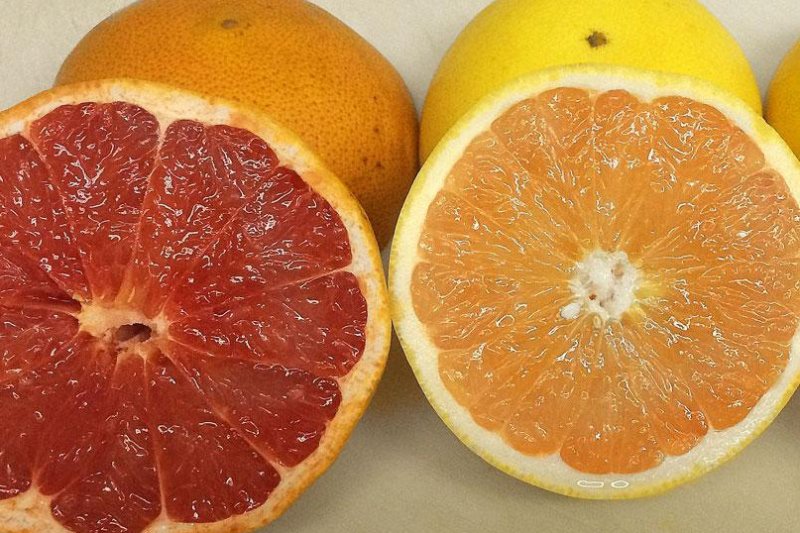Citrus farmers in Florida are trying new varieties of grapefruit that may be more resistant to citrus greening disease. Photo courtesy of Peace River Citrus
ORLANDO, Fla., Oct. 7 (UPI) -- Florida grapefruit growers are trying to help preserve the industry with new plantings, taking a risky step in the face of disease and storms that continue to decimate their groves.
Two large grapefruit growers on the state's Atlantic coast have committed to planting 1,500 acres of new trees -- the biggest grapefruit planting the state has seen in years. Key participants in the plan acknowledge significant risks, though, with citrus greening still sickening trees throughout the state.
At stake is a segment of an industry that has a $10 billion-plus economic impact in Florida, with some 60,000 jobs, according to Florida Department of Agriculture and Consumer Services.
Growers are using new strategies to combat citrus greening, which is spread by the pin-size psyllid insect. Canker also took its toll on Florida's citrus groves before citrus greening -- but greening is by far the biggest threat now.
Orange and grapefruit groves are trying new varieties that have shown resistance to greening. Screens are being used to cover new trees and keep the bugs out. New fertilizer techniques help the trees survive longer, too. But the uncertainty of success in planting so many new trees is high.
Risky plan
"Yes there is risk. We don't have our heads in the sand," said Dan Richey, of the Scott Family citrus companies based in Vero Beach. It is the biggest investor in the project, estimated to cost $25 million once all 1,500 acres are planted.
That company has partnered with Peace River Citrus, also based in Vero Beach, and Coca-Cola has agreed to buy juice from the venture. Japan-based Takasago International is paying $1.5 million to cover the cost of the trees and is guaranteeing purchase of grapefruit peel oil for flavors and fragrance.
"We're at a point now where if we don't recreate the industry from the ground up, the infrastructure collapses -- and we don't want that," Richey said.
Coca-Cola is supporting the new grapefruit planting by committing to buy juice for its brands, such as Minute Maid, for 20 years at a minimum price. The drink manufacturer also backed a large orange tree planting in Florida starting in 2013 -- a $2 billion project spread over 25,000 acres.
Florida has been the nation's leader in citrus production since the 1800s, but that level had dropped closer to that of California in recent years. Florida has a well-developed network of groves, packers, processors and rail lines that connect them. That network is collapsing, though, because growers have faced increasing hardships in recent years.
For example, even though citrus canker had been found in the state since 1910, previous outbreaks of that disease were successfully eradicated just by chopping down infected trees. But hurricanes in 2004 spread the disease to more than 25 counties, and in 2005, the state gave up trying to chop down infected trees.
Since then, growers have had to live with the disease by managing it with chemicals and best growing practices.
Greening a big threat
The newer and more dire threat of citrus greening was first discovered in groves around 2005, according the University of Florida. That's when steep losses in state citrus production really began. Farmers who had struggled to hold on during the canker wars then had to deal with a double whammy.
Citrus acres in Florida dropped to 402,000 in 2018 from 679,000 in 2004, while the number of growers plummeted to 2,775 in 2017 from 7,389 in 2002, according to UF assistant professor Ariel Singerman. Hurricane Irma in 2017 also damaged thousands of acres of orange and grapefruit trees.
Forty-one juice-processing plants operated in 2004, but only 14 were running in 2017. And Florida Citrus Mutual, the industry's advocacy group, said last month that only seven major citrus-processing plants remain open. There once were 80 packing houses, but that dropped to 26 in 2017.
Citrus production hit a record high of 244 million boxes in the late 1990s. But citrus greening and Hurricane Irma reduced that to just over 45 million boxes during the 2017-18 crop year. Last year's crop recovered a little, but still was one-fourth of the record high.
Citrus canker and citrus greening are both native to Asia, which is where citrus originated, as well, said Jim Graham, a UF emeritus professor of soil microbiology. He said Florida escaped those diseases in the first decades after citrus became widespread around the turn of the century.
"Grapefruit in general is particularly vulnerable to citrus greening. It usually doesn't even make it to the fruiting stage," Graham said. For that reason, success with a new grapefruit planting could signal a turning point in the war against citrus disease."
Star Ruby chosen
The grapefruit project led by the Scott family will attempt to plant a different type of grapefruit, the Star Ruby, which was developed at Texas A&I University and made available to the public in 1977. It is popular in California.
Previously, in the Vero Beach area, most grapefruit were Ruby Red -- which succumbed quickly to citrus greening.
Graham said the Star Ruby is a better bet than Ruby Red.
"Star Ruby trees are showing better conditions. I've seen that myself. But we don't know whether that variety will show less susceptibility in new plantings," Graham said.
In general, the state advises growers to try new varieties on a small scale for a few years to see how they hold up. But growers feel an urgency to preserve the infrastructure and workforce, Richey said.
"The approach is a collaborative effort to mitigate the risk. It's a big project, but at this point, you can't be half pregnant -- either we go big or we see the industry collapse," he said.















